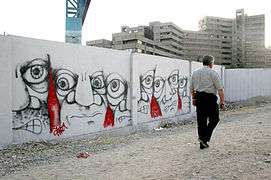Remix culture

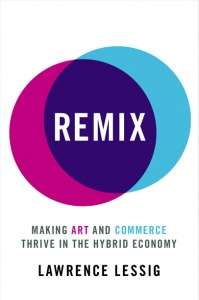
Remix culture, sometimes read-write culture, is a society that allows and encourages derivative works by combining or editing existing materials to produce a new product.[3][4] A remix culture would be, by default, permissive of efforts to improve upon, change, integrate, or otherwise remix the work of copyright holders. Since the early 2000s[5][6] and in his 2008 book Remix, Harvard law professor Lawrence Lessig presents this as a desirable idea for the digital age. Lessig also founded the Creative Commons in 2001 which released Licenses as tools to enable remix culture again, as remixing is legally prevented by the default exclusive copyright regime applied currently on intellectual property. The remix culture for cultural works is related and inspired by the earlier Free and open source software for software movement, which encourages the reuse and remixing of software works.
Description
Lawrence Lessig described the Remix culture in comparison to the default media culture of the 20th century under usage of computer technology terminology as Read/Write culture (RW) vs. Read Only culture (RO).[7]
In the usual Read Only media culture is the culture consumed more or less passively.[7] The information or product is provided by a 'professional' source, the content industry, that possesses an authority on that particular product/information. There is a one-way flow only of creative content and ideas due to a clear role separation between content producer and content consumer. The emergence of Analog mass production and duplication technologies (pre-Digital revolution and internet like radio broad-casting) inherently enabled the RO culture's business model of production and distribution and limited the role of the consumer to consumption of media.
Digital technology does not have the 'natural' constraints of the analog that preceded it. RO culture had to be recoded in order to compete with the "free" distribution made possible by the Internet. This is primarily done in the form of Digital Rights Management (DRM), which imposes largely arbitrary restrictions on usage. Regardless, DRM has proven largely ineffective in enforcing the constraints of analog media.[8][9]
As opposed to RO culture, Read/Write culture has a reciprocal relationship between the producer and the consumer. Taking works, such as songs, and appropriating them in private circles is exemplary of RW culture, which was considered to be the 'popular' culture before the advent of reproduction technologies.[7] The technologies and copyright laws that soon followed, however, changed the dynamics of popular culture. As it became professionalized, people were taught to defer production to the professionals.
Digital technologies provide the tools for reviving RW culture and democratizing production, sometimes referred to as Web 2.0. Blogs explain the three layers of this democratization. Blogs have redefined our relationship to the content industry as they allowed access to non-professional, user-generated content. The 'comments' feature that soon followed provided a space for readers to have a dialogue with the amateur contributors. 'Tagging' of the blogs by users based on the content provided the necessary layer for users to filter the sea of content according to their interest. The third layer added bots that analyzed the relationship between various websites by counting the clicks between them and, thus, organizing a database of preferences. The three layers working together established an ecosystem of reputation that served to guide users through the blogosphere. While there is no doubt many amateur online publications cannot compete with the validity of professional sources, the democratization of digital RW culture and the ecosystem of reputation provides a space for many talented voices to be heard that was not available in the pre-digital RO model.
Domains of remixing
Folklore

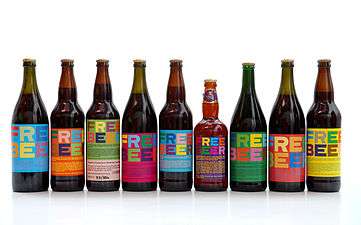
- Folklore existed long before any copyright law. All folk tales, folk songs, folk art, folk poetry, etc. was revised constantly through the folk process. According to Ramsay Wood,[12] the oldest known example of remix culture is the Panchatantra, an ancient Indian collection of interrelated animal fables in verse and prose, arranged within a frame story. The original Sanskrit work is believed to be composed around the 3rd century BCE,[10] based on older oral traditions, including "animal fables that are as old as we are able to imagine".[11] The Panchatantra was reinterpreted in the following 2300 years at least 200 times in 50 different languages all around the world.[13][14][15]
- Cooking recipes might be among the oldest knowledge of the mankind which was inherited further and shared unrestricted for adaption and improvement. A recent example is the Free Beer project of Superflex which has recipe and label artwork under a creative commons license, actively encouraging free adaption and reuse.
- Parodies are a form of satire that adapts another work of art in order to ridicule it and going back at least to the ancient Greek times. Parody exists in all art media, including literature, music and cinema.
Graffiti
- Graffiti is an example of read/write culture where the participants interact with their surroundings and environment. In much the same way that advertisements decorate walls, graffiti allows the public to choose the images to have displayed on their buildings. By using spray paint, or other mediums, the artists essentially remix and change the wall or other surface to display their twist or critique. As example, Banksy is a notable contemporary English graffiti artist.
Books and other information
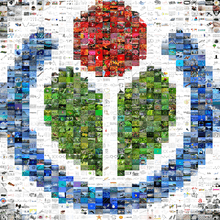
- Wikipedia is an example of a written remix, where the public is encouraged to add their knowledge in an encyclopedia. The wiki-based website essentially allows a user to remix the information presented. Amazon.com called Wikipedia "the world's most exhaustive and up-to-date encyclopedia" because it is edited and produced by such a large pool of people.[16]
- Scanlations are fan-made translations of comics from a language into another language.
- Book mashups, combining multiple books, received in 2009 wider reception with Seth Grahame-Smith's Pride and Prejudice and Zombies.
- The OpenStreetMap project creates since 2004 a free editable map of the world,[17] with over 2 million registered users who collect data using manual survey, GPS devices, aerial photography, and other free sources.[18]
- The Wikimedia Commons is digital data repository open for free content contribution from the public. The content, mostly images and sound files, is licensed under Creative Commons licenses enabling free reuse and remixing by anyone. Another examples are the collaborative image hosting sites Flickr and Deviantart who offer Creative commons license options.
Software and other digital goods
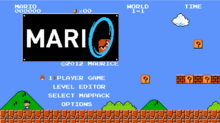
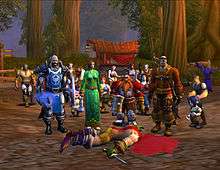
Software as digital good is well suited for adaption and remixing.
- Pre-internet Public domain software of the 1960s and 1970s was software which was shared, edited and improved constantly also as type-in programs. As kind of successor the Free and open source software movement can be seen, with the rise of the web.
- In the Free and open source software culture, established in the 1990s as opposition to the "Read-only" proprietary software, sharing, forking and reusing is natural part of the development model. For instance, the Linux operating system, with its commercial offsprings Android and ChromeOS, is a highly successful result of a software "remix culture".
- The arrival of Internet facing software repositories helped the remix software development model enormously in the 2000s. GitHub helped since 2008 further the collaborative software development in remix style, especially web development.
- Fangames are video games made by fans based on one or more established video games, often acting as sequel when no official sequel exists. Dōjin soft is the Japan specific variant, and homebrew typically for proprietary hardware consoles.
- Video game modding is the creative adaption of a released video game.[20] In the 2000s the video game industry noticed the potential and supports often mod makers actively with modding kits. Special cases are fan patches and Fan translation of video games who made by fans to alleviate bugs or shortcomings.
- Machinimas are fan-made videos "remixed" from and with video games, going far beyond the original scope and intend.
- Retrocomputing and computer and digital preservation activities as emulation and reverse engineering were described as aspects of the remixing culture.[21]
Music
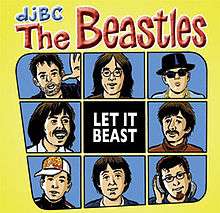
- DJing the act of live rearranging and remixing pre-recorded music material to new compositions. From this music, the term remix spread to other domains.
- Sampling in music making is an example of reuse and remix to produce a new work. Sampling is widely popular within hip-hop culture. Grandmaster Flash and Afrika Bambaataa were some of the earliest hip-hop artists to employ the practice of sampling. This practice can also be traced to artists such as Led Zeppelin, who interpolated substantial portions of music by many acts including Willie Dixon, Howlin' Wolf, Jake Holmes, and Spirit.[22] By taking a small clip of an existing song, changing different parameters such as pitch, and incorporating it into a new piece, the artist can make it their own.
- Music mashups are blends of existing music tracks. For instance the mashup album The Beastles received in 2004 acclaim[23][24] and was featured in Newsweek[25] and Rolling Stone.[26] A second album named Let It Beast with cover art by cartoonist Josh Neufeld was produced in 2006.
- Arrangements involve taking an already existing melody and reconceptualizing them into a new song. The term "remix" is often used within internet communities as a synonym for this practice.
Movies
In film, remixing is often done and happens in many forms.
- Most new movies are adaptations of comics, graphic novels, books, or other forms of media. The majority of other Hollywood cinema works are typically genre films that follow strict generic plots.[27] These forms of movies hardly appear original and creative, but rather rely on adapting material from previous works or genre formulas, which is a form of remix. A prime example is the film Kill Bill which takes many techniques and scene templates from other films (predating all this were The Magnificent Seven, an official remake of The Seven Samurai along with Sergio Leone's A Fistful Of Dollars).[28]
- Video mashups combine multiple pre-existing video sources with no discernible relation with each other into a unified video. Examples of mashup videos include movie trailer remixes, vids, YouTube Poop, and supercuts.[29][30]
- Vidding is the fan labor practice in media fandom of creating music videos from the footage of one or more visual media sources, thereby exploring the source itself in a new way. The specialized form for animation shows is called Anime music videos, also made by fans.
- VJing, similarly as DJing is the realtime manipulation of imagery through technological mediation and for an audience, in synchronization to music.[31]
- Fandubs and Fansubs are reworks of fans on released film material.
- Walt Disney works are important company remixing examples, for instance Beauty and the Beast, Aladdin, Frozen. These remixes are based on earlier public domain works (although Disney films altered from their original sources).[32][33] Lawrence Lessig called therefore Walt Disney a "remixer extraordinaire" and praised him as ideal of the remix culture in 2010.[34] Some journalist report that Disney tolerates remixes of fans (Fan art) easier than in former times.[35]
Remixing in religion
Throughout history remix culture has been truthful not only in exchange of oral stories but also in the bible. This is a book of stories and lessons that has been compiled and remixed over generations.[36] As another example it is thought that the beliefs of Buddhism has influenced other religious practices and ways.[37]
Intertwining of media cultures
For Remix culture to survive it must be shared and created or "remixed" by contributors. This is where Participatory culture come into play, because consumers start participating by becoming contributors especially many teens growing up with these media cultures.[38] A book was published in 2013 by Henry Jenkins called "Reading in a Participatory Culture" which focuses on his technique of remixing the original story Moby Dick to make it a new and fresh experience for students.[39][40] This form of teaching enforces the correlation between participatory and remix culture while highlighting it's importance in evolving literature.
Effects of remix culture on artists
Remix culture has created an environment that is nearly impossible for artists to have or own "original work".[41] Media and the internet has made art so public that it leaves the work up for other interpretation and in return, remixing. A major example of this in the 21st century is the idea of memes. Once one is put into cyberspace it is automatically assumed that someone else can come along and remix the picture.[42]
History
Remixing was always a part of the human culture.[43] For instance US media scholar Professor Henry Jenkins argued that “the story of American arts in the 19th century might be told in terms of the mixing, matching and merging of folk traditions taken from various indigenous and immigrant populations.” Another historical example of remixing is Cento, a literary genre popular in Medieval Europe consisting mainly of verses or extracts directly borrowed from the works of other authors and arranged in a new form or order.[43]
The balance between creation and consumption shifted with the technological progress on media recording and reproduction. Notable events are the invention of book printing press and the analog Sound recording and reproduction leading to severe cultural and legal changes.
Analog era
In the begin of the 20th century on the dawn of the analog Sound recording and reproduction revolution John Philip Sousa, an American composer and conductor of the late Romantic era, warned in 1906 in a congressional hearing on a negative change of the musical culture by the now available "canned music".[44][45]
"These talking machines are going to ruin the artistic development of music in this country. When I was a boy...in front of every house in the summer evenings, you would find young people together singing the songs of the day or old songs. Today you hear these infernal machines going night and day. We will not have a vocal cord left. The vocal cord will be eliminated by a process of evolution, as was the tail of man when he came from the ape."
Specialized, expensive creation devices ("read-write") and specialized cheap consumption ("read-only") devices allowed a centralized production by few and decentralized consumption by many. Analog devices for consumers for low prices, lacking the capability of writing and creating, spread out fast: Newspapers, Jukebox, radio, television. This new business model, an Industrial information economy, demanded and resulted in the strengthening of the exclusive copyright and a weakening of the remix culture and the Public domain in throughout the 19th and 20th century.
Analog creation devices were expensive and also limited in their editing and rearranging capability. An analog copy of a work (e.g. an audio tape) cannot be edited, copied and worked on infinite often as the quality continuously worsens. Despite that, a creative remixing culture survived to some limited degree. For instance composer John Oswald coined in 1985 the Plunderphonics term in his essay Plunderphonics, or Audio Piracy as a Compositional Prerogative for sound collages based on existing audio recordings and altering them in some way to make a new composition.
Remixing as digital age phenomena

The technological situation changed fundamentally with the digital revolution,[46] digital information could be reproduced and edited infinite often without quality loss. Still, in the 1960s the first digital general computing devices with such capabilities were meant only for specialists and professionals and were extremely expensive; first consumer oriented devices like video game consoles inherently lacked again the RW capability. But the arrival in the 1980s of the home computer and especially the IBM personal computer brought a digital prosumer device, a device usable for production and consumption at the same time, to the masses for an affordable price.[47][48] Similarly for software, in the 1990s the free and open source software movement implemented a software ecosystem based on the idea of edit-ability by anyone.
Internet and web 2.0
The arrival of the Internet on end 1990s/begin 2000s in all domains of art, technology and society created a highly effective way to re-implement a "remix culture" again. Unlike earlier TV and radio, with an unidirectional information transport (producer to consumer), the Internet is inherently bidirectional, enabling a peer-to-peer dynamic. This accelerated with the Web 2.0 and more user-generated content due to Commons-based peer production possibilities. Remixes of songs, videos, and photos are easily distributed and created. There is a constant revision to what is being created, which is done on both a professional and amateur scale. The availability of various end-user oriented software such as GarageBand and Adobe Photoshop make it easy to remix. The Internet allows distribution of remixes to the masses. Internet memes are an Internet-specific creative content which got created, filtered and transformed by the viral spreading process made possible by the web and its users.
Foundation of the Creative Commons

As response to a more restrictive becoming copyright system (Sonny Bono Copyright Term Extension, DMCA), which started to limit the blooming sharing and remixing activities of the web, in 2001 Lawrence Lessig founded the Creative Commons. In 2002 the Creative Commons released a set of Licenses as tools to enable remix culture, by allowing a balanced, fair enabling release of creative works, "some rights reserved" instead of the usual "all rights reserved". Several companies and governmental organizations adapted this approach and licenses in the following years, for instance flickr, DeviantART and Europeana using or offering CC license options which allow remixing. There are several webpages addressing this remix culture, for instance ccMixter founded 2004.
The 2008 open-source film by Brett Gaylor RiP!: A Remix Manifesto documents "the changing concept of copyright".[49][50]
In 2012 Canada's Copyright Modernization Act explicitly added a new exemption which allows non-commercial remixing.[51] In 2013 the US court ruling Lenz v. Universal Music Corp. acknowledged that amateur remixing might fall under fair use and copyright holders are requested to check and respect fair use before doing DMCA take down notices.[52]
Copyright
Under copyright laws of many countries, anyone with the intent to remix an existing work is liable for lawsuit because the laws protect the intellectual property of the work. However, current copyright laws are proving to be ineffective at preventing sampling of content.[53][54] On the other hand, fair-use does not address a wide enough range of use-cases and its borders are not well established and defined, making usage under "fair use" legally risky. Lessig argues that there needs to be a change in the current state of copyright laws to legalize remix culture, especially for fair-use cases. He states that "outdated copyright laws have turned our children into criminals."[55] One proposition is to adopt the system of citation used with book references. The artist would cite the intellectual property she sampled which would give the original creator the credit, as is common with literature references. As tools for doing so Lawrence Lessig proposed the Creative Commons licenses which demand for instance Attribution without restricting the general use of a creative work. One step further is the Free content movement, which proposes that creative content should be released under free licenses. The Copyright reform movement tries to tackle the problem by cutting for instance the excessive long copyright terms, as it was debated by scholar Rufus Pollock.[56][57]
Other (copyright) scholars, such as Yochai Benkler and Erez Reuveni,[58] promulgate ideas that are closely related to remix culture in 2007. Some scholars argue that the academic and legal institutions must change with the culture towards one that is remix based.[59]
Reception and impact
In his 2006 book Cult of the Amateur.",[60] Web 2.0 critic Andrew Keen criticizes Free and Read-Write Culture.
In February 2010 Cato Institute's Julian Sanchez praised the remix activities for its social value, "for performing social realities" and remarked that copyright should be evaluated regarding the "level of control permitted to be exercised over our social realities".[61][62]
According to Kirby Ferguson in 2011 and his popular TED talk series,[63] everything is a remix, and that all original material builds off of and remixes previously existing material.[64] He argues if all intellectual property is influenced by other pieces of work, copyright laws would be unnecessary.
In June 2015 a WIPO article named "Remix Culture and Amateur Creativity: A Copyright Dilemma"[52] acknowledged the "age of remixing" and the need for a copyright reform.
Critics like UC Davis professor Thomas W. Joo criticized remix culture for romanticizing free culture.[65][66]
See also
References
- ↑ downloads on creativecommons.org "The building blocks icon used to represent “to remix” is derived from the FreeCulture.org logo."
- ↑ Remix on lessig.org
- ↑ Remixing Culture And Why The Art Of The Mash-Up Matters on Crunch Network by Ben Murray (Mar 22, 2015)
- ↑ Ferguson, Kirby. "Everything Is A Remix". Retrieved 2011-05-01.
- ↑ "Remix Is a Cultural Right, Lessig Says". law.virginia.edu. 2004-11-18. Retrieved 2016-02-27.
- ↑ Lessig on OSCON 2002
- 1 2 3 Larry Lessig (2007-03-01). "Larry Lessig says the law is strangling creativity". TEDx. ted.com. Retrieved 2016-02-26.
- ↑ A New Deal for Copyright on Locus Magazine by Cory Doctorow (2015)
- ↑ The Role of Scientific and Technical Data and Information in the Public Domain: Proceedings of a Symposium. on National Academies Press (US); 15. The Challenge of Digital Rights Management Technologies by Julie Cohen (2003)
- 1 2 Jacobs 1888, Introduction, page xv; Ryder 1925, Translator's introduction, quoting Hertel: "the original work was composed in Kashmir, about 200 B.C. At this date, however, many of the individual stories were already ancient."
- 1 2 Doris Lessing, Problems, Myths and Stories, London: Institute for Cultural Research Monograph Series No. 36, 1999, p 13
- ↑ See page 262 of Kalila and Dimna, Selected fables of Bidpai [Vol 1], retold by Ramsay Wood, Knopf, New York, 1980; and the Afterword of Medina's 2011 Fables of Conflict and Intrigue (Vol 2)
- ↑ Introduction, Olivelle 2006, quoting Edgerton 1924.
- ↑ Ryder 1925, Translator's introduction: "The Panchatantra contains the most widely known stories in the world. If it were further declared that the Panchatantra is the best collection of stories in the world, the assertion could hardly be disproved, and would probably command the assent of those possessing the knowledge for a judgment."
- ↑ Edgerton 1924, p. 3. "reacht" and "workt" have been changed to conventional spelling: '"...there are recorded over two hundred different versions known to exist in more than fifty languages, and three-quarters of these languages are extra-Indian. As early as the eleventh century this work reached Europe, and before 1600 it existed in Greek, Latin, Spanish, Italian, German, English, Old Slavonic, Czech, and perhaps other Slavonic languages. Its range has extended from Java to Iceland... [In India,] it has been worked over and over again, expanded, abstracted, turned into verse, retold in prose, translated into medieval and modern vernaculars, and retranslated into Sanskrit. And most of the stories contained in it have "gone down" into the folklore of the story-loving Hindus, whence they reappear in the collections of oral tales gathered by modern students of folk-stories."
- ↑ "Kindle 3G Wireless Reading Device". Amazon.com. 2010-08-04. Archived from the original on 2010-08-04.
Wireless Access to Wikipedia Kindle also includes free built-in access to the world's most exhaustive and up-to-date encyclopedia, Wikipedia.org. With Kindle in hand, looking up people, places, events, and more has never been easier. It gives whole new meaning to the phrase walking encyclopedia.
line feed character in|quote=at position 29 (help) - ↑ Lardinois, Frederic (9 August 2014). "For the Love of Mapping Data". TechCrunch.
- ↑ Neis, Pascal,; Zipf, Alexander, (2012), "Analyzing the Contributor Activity of a Volunteered Geographic Information Project — The Case of OpenStreetMap", ISPRS Int. J. Geo-Inf., 1 (2): 146–165, doi:10.3390/ijgi1020146
- ↑ Puts a Portal Gun in Super Mario Bros on Kotaku (2012)
- ↑ Computer game mods, modders, modding, and the mod scene by Walt Scacchi on First Monday Volume 15, Number 5 (3 May 2010)
- ↑ Yuri Takhteyev, Quinn DuPont (2013). "Retrocomputing as Preservation and Remix" (PDF). iConference 2013 Proceedings (pp. 422-432). doi:10.9776/13230. University of Toronto. Retrieved 2016-03-26.
This paper looks at the world of retrocomputing, a constellation of largely non-professional practices involving old computing technology. Retrocomputing includes many activities that can be seen as constituting “preservation.” At the same time, it is often transformative, producing assemblages that “remix” fragments from the past with newer elements or joining together historic components that were never combined before. While such “remix” may seem to undermine preservation, it allows for fragments of computing history to be reintegrated into a living, ongoing practice, contributing to preservation in a broader sense. The seemingly unorganized nature of retrocomputing assemblages also provides space for alternative “situated knowledges” and histories of computing, which can sometimes be quite sophisticated. Recognizing such alternative epistemologies paves the way for alternative approaches to preservation.
- ↑ Ferguson, Kirby. "Everything's A Remix". Retrieved 2011-05-01.
- ↑ "The sound of surprise: Looking for Boston's best". Boston Phoenix. Retrieved 2008-05-22.
- ↑ "Best (and worst) music of 2004". Retrieved 2008-05-22.
- ↑ N'Gai Croal (March 6, 2006). "Time for your mash-up?". Newsweek. Retrieved 2008-05-22.
- ↑ Brian Hiatt. "Mash-up corner". Rolling Stone. Retrieved 2008-05-22.
- ↑ Ferguson, Kirby. "Everything's A Remix Part 2". Everything's A Remix.
- ↑ Ferguson, Kirby. "Kill Bill Extended Look". Everything's A Remix.
- ↑ "In the matter of exemption to prohibition on circumvention of copyright protection systems for access control technologies" (PDF). Electronic Frontier Foundation.
- ↑ http://blogs.wsj.com/digits/2011/08/04/tech-diary-video-mashups-a-new-kind-of-art/
- ↑ "VJ: an artist who creates and mixes video live and in synchronization to music". - Eskandar, p.1.
- ↑ 50 Disney Movies Based On The Public Domain on forbes.com (2014)
- ↑ How Mickey Mouse Evades the Public Domain on priceonomics.com (Jan 7, 2016)
- ↑ Lawrence Lessig (2010-04-01). "Re-examining the remix" (video). TEDxNYED. ted.com. Retrieved 2016-02-27.
Time 9:30: "This man (Walt Disney) is a Remixer extraordinaire, he is the celebration and ideal of exactly this kind of creativity."
- ↑ How Disney learned to stop worrying and love copyright infringement on salon.com by Andrew Leonard (2014)
- ↑ "10 Ways The Bible Was Influenced By Other Religions". Listverse. 2013-06-30. Retrieved 2016-11-27.
- ↑ "Buddhism's Influences on Other Religions". Our Everyday Life. Retrieved 2016-11-27.
- ↑ Street, 1615 L.; NW; Washington, Suite 800; Inquiries, DC 20036 202 419 4300 | Main 202 419 4349 | Fax 202 419 4372 | Media (2005-11-02). "57% of Teen Internet Users Create, Remix or Share Content Online". Pew Research Center: Internet, Science & Tech. Retrieved 2016-11-26.
- ↑ "There She Blows! Reading in a Participatory Culture and Flows of Reading Launch Today". henryjenkins.org. Retrieved 2016-11-27.
- ↑ Jenkins, Henry; Kelley, Wyn; Clinton, Katie; McWilliams, Jenna; Pitts-Wiley, Ricardo (2013-01-01). Reading in a Participatory Culture: Remixing Moby-Dick in the English Classroom. Teachers College Press. ISBN 9780807754016.
- ↑ maddysulla (2014-04-07). "Remix Culture: Its Own Art Form or the Death of Creativity?". Digital Media & Cyberculture. Retrieved 2016-11-27.
- ↑ "Memes and Participatory Culture". Networked Culture 3020 Wikia. Retrieved 2016-11-27.
- 1 2 Rostama, Guilda (June 1, 2015). "Remix Culture and Amateur Creativity: A Copyright Dilemma". WIPO. Retrieved 2016-03-14.
Most cultures around the world have evolved through the mixing and merging of different cultural expressions.
- ↑ Bierley, Paul Edmund, "The Incredible Band of John Philip Sousa". University of Illinois Press, 2006. Page 82
- ↑ Lawrence Lessig, 2008, Remix: making art and commerce thrive in the hybrid economy, London: Bloomsbury Academic. Chapter 1. "These talking machines are going to ruin the artistic development of music in this country. When I was a boy...in front of every house in the summer evenings, you would find young people together singing the songs of the day or old songs. Today you hear these infernal machines going night and day. We will not have a vocal cord left. The vocal cord will be eliminated by a process of evolution, as was the tail of man when he came from the ape."
- ↑ Rostama, Guilda (June 1, 2015). "Remix Culture and Amateur Creativity: A Copyright Dilemma". WIPO. Retrieved 2016-03-14.
In a further twist, widespread access to ever more sophisticated computers and other digital media over the past two decades has fostered the re-emergence of a “read-write” culture.
- ↑ The Coming War on General Computation at 28C3 by Cory Doctorow (2011-12-30)
- ↑ Prosumption by pineight.com
- ↑ Kirsner, Scott. "CinemaTech Filmmaker Q&A: Brett Gaylor of Open Source Cinema".
- ↑ Sinnott, Shane. "The Load-Down", Montreal Mirror, 2007-03-29. Accessed 2008-06-30
- ↑ Rostama, Guilda (June 1, 2015). "Remix Culture and Amateur Creativity: A Copyright Dilemma". WIPO. Retrieved 2016-03-14.
Canada is one of a few countries, if not the only one, to have introduced into its copyright law a new exception for non-commercial user-generated content. Article 29 of Canada’s Copyright Modernization Act (2012) states that there is no infringement if: (i) the use is done solely for non-commercial purpose; (ii) the original source is mentioned; (iii) the individual has reasonable ground to believe that he or she is not infringing copyright; and (iv) the remix does not have a “substantial adverse effect” on the exploitation of the existing work.
- 1 2 Rostama, Guilda (June 1, 2015). "Remix Culture and Amateur Creativity: A Copyright Dilemma". WIPO. Retrieved 2016-03-14.
in 2013 a district court ruled that copyright owners do not have the right to simply take down content before undertaking a legal analysis to determine whether the remixed work could fall under fair use, a concept in US copyright law which permits limited use of copyrighted material without the need to obtain the right holder’s permission (US District Court, Stephanie Lenz v. Universal Music Corp., Universal Music Publishing Inc., and Universal Music Publishing Group, Case No. 5:07-cv-03783-JF, January 24, 2013).[...] Given the emergence of today’s “remix” culture, and the legal uncertainty surrounding remixes and mash-ups, the time would appear to be ripe for policy makers to take a new look at copyright law.
- ↑ Johnsen, Andres. "Good Copy, Bad Copy". Archived from the original on 2013-03-06. Retrieved 2011-04-14.
- ↑ Is Sampling Always Copyright Infringement? by Tomasz Rychlicki and Adam Zieliński (November 2009)
- ↑ Colbert, Steven. "The Colbert Report- Lawrence Lessig". The Colbert Report. Retrieved 2011-04-25.
- ↑ Rufus Pollock (1 October 2007). "Optimal copyright over time: Technological change and the stock of works" (PDF). University of Cambridge. Archived from the original (PDF) on 21 February 2013. Retrieved 11 January 2015.
The optimal level for copyright has been a matter for extensive debate over the last decade. Using a parsimonious theoretical model this paper contributes several new results of relevance to this debate. In particular we demonstrate that (a) optimal copyright is likely to fall as the production costs of 'originals' decline (for example as a result of digitization) (b) technological change which reduces costs of production may imply a decrease or a decrease in optimal levels of protection (this contrasts with a large number of commentators, particularly in the copyright industries, who have argued that such change necessitates increases in protection) (c) the optimal level of copyright will, in general, fall over time as the stock of work increases.
- ↑ Rufus Pollock (15 June 2009). "Forever minus a day? Calculating optimal copyright term" (PDF). University of Cambridge. Archived from the original (PDF) on 12 January 2013. Retrieved 11 January 2015.
The optimal term of copyright has been a matter for extensive debate over the last decade. Based on a novel approach we derive an explicit formula which characterises the optimal term as a function of a few key and, most importantly, empirically-estimable parameters. Using existing data on recordings and books we obtain a point estimate of around 15 years for optimal copyright term with a 99% confidence interval extending up to 38 years. This is substantially shorter than any current copyright term and implies that existing terms are too long.
- ↑ Erez Reuveni, "Authorship in the Age of the Conducer", Social Science Research Network, January 2007
- ↑ Selber, Stuart (December 2007). "Plagiarism, Originality, Assemblage". Computers & Composition. 24 (4): 375–403. doi:10.1016/j.compcom.2007.08.003.
- ↑ Keen, Andrew (May 16, 2006). Web 2.0; The second generation of the Internet has arrived. It's worse than you think. The Weekly Standard
- ↑ Julian Sanchez (2010-04-01). "Lawrence Lessig: Re-examining the remix" (video). TEDxNYED. ted.com. Retrieved 2016-02-27.
Time 7:14: "social remixes [...] for performing social realities"; 8:00 "copyright policies about [...] level of control permitted to be exercised over our social realities"
- ↑ The Evolution of Remix Culture by Julian Sanchez (2010-02-05)
- ↑ THOUGHTS ON REMIX CULTURE, COPYRIGHT, AND CREATIVITY by Melanie Picard (August 6, 2013)
- ↑ Ferguson, Kirby. "Everything's A Remix". Everything Is A Remix Part 1. Retrieved 2011-05-02.
- ↑ Remix Without Romance: What Free Culture Gets Wrong by Terry Hart (April 18, 2012)
- ↑ Remix Without Romance Connecticut Law Review Vol.44 by THOMAS W. JOO (December 2011)
External links
- Video resources
- Total Recut
- Everything Is a Remix
- Remixthebook by Mark Amerika
- Remix Theory by Eduardo Navas
- RE/Mixed Media Festival
